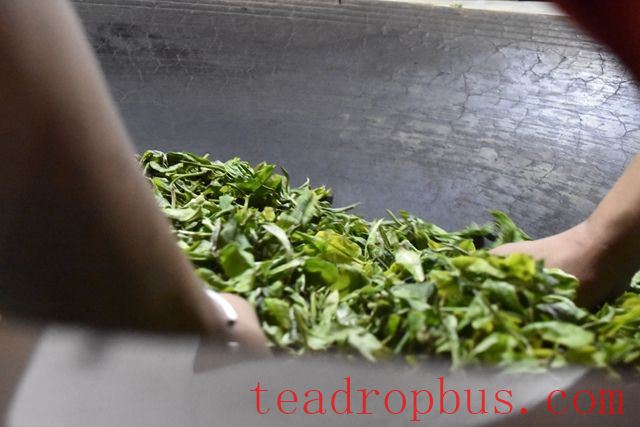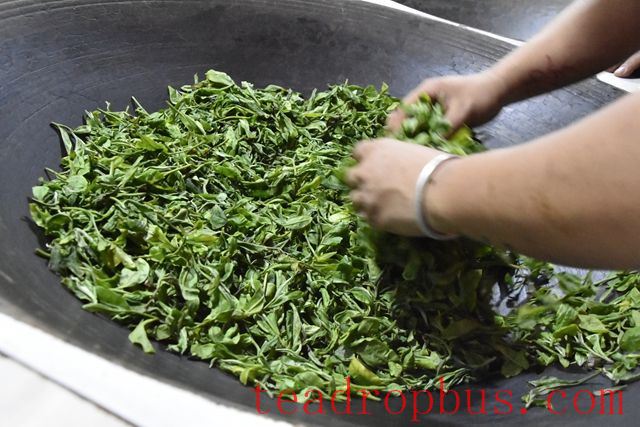The fixation methods for Puer Tea are divided into Wok stir-frying and drum fixation. Wok stir-frying, also known as manual fixation, is commonly used for ancient tree teas and wild-grown teas. This involves heating a wok, adding the leaves, and continuously tossing them with clean hands. Drum fixation, or mechanical fixation, is used more often for ordinary quality teas. After some training to master the machinery's operation, one can control the force effectively.

The Fixation Methods for Puer Tea
1. Traditional Hand Stir-Frying
This method primarily uses a wok for fixation. It is the oldest technique and requires a high level of skill from the tea maker, including controlling the temperature of the wok, the gesture and speed of stirring, and the timing. A skilled artisan can introduce various new elements during fixation, allowing the tea to develop different flavors, aromas, and colors. For a tea person, this can be a source of enjoyment.
2. Mechanical Fixation
Mechanical fixation is a more stable method, with better production and hygiene conditions compared to hand stir-frying. Once the fixed temperature, time, and other parameters are set, mass production can begin. Both hand stir-frying and mechanical fixation have their merits, and there's no need to argue which is superior. The important thing is to drink what tastes good to you.

The magic of fixation lies in its ability to blunt the enzymatic reactions within fresh tender leaves, inhibiting the oxidation of polyphenolic compounds while preserving the chlorophyll in the leaves. This ensures that when you Brew the tea in the future, it still retains its vibrant green color.
The Most Important Process in Puer Tea: Fixation
The purpose of fixation is to inhibit enzyme activity and slow down the fermentation process. During the fixation of Puer tea, the wok temperature is controlled above 200°C, while the Leaf surface temperature is maintained between 60°C and 80°C. High temperatures kill part of the active enzymes, slowing down the change in the tea. If there are too many active enzymes, the tea will quickly turn red, affecting its color, aroma, and flavor. Although high temperatures kill some active enzymes, the presence of water in the tea cells allows enough enzymes to remain to facilitate the transformation of Puer tea. Fixation also matures the tea, reducing its raw taste, softening the leaves to make them easier to roll without breaking. Traditional fixation in Puer tea usually involves manual stir-frying in a wok. The stove reaches waist height, and the iron wok is tilted at about 30 degrees, making it convenient for stirring. Wood fire heats the wok to over 150°C before fresh leaves are added, typically 5-10 kilograms per batch. During fixation, the wok temperature reaches 200°C, and the leaf surface temperature is kept between 60°C and 80°C. At this point, the enzyme activity is only blunted, not “killed.” Manual fixation requires the tea maker to be very experienced, able to control the heat well and maintain a uniform and orderly stirring frequency. An experienced fixation master can effectively highlight the advantages of high-quality raw materials.

In the past, tea farmers faced difficult conditions; they would often use the same wok for cooking and then stir-fry the tea, leading to the smoky flavor found in many old teas. Today, with the development of Puer tea, experienced and advanced initial processing facilities have been established on the mountains, responsible for the fixation and initial processing of fresh leaves, providing high-quality sun-dried rough tea for further processing.
Insufficient or excessive fixation can have a fatal impact on the quality of Puer tea. Insufficient fixation fails to meet the requirements for blunting the active enzymes in the tea and does not effectively release the aroma substances, resulting in an overly grassy flavor that affects the taste. Even after aging, the strong grassiness may fade slightly, but the flavor remains subpar. Using such rough material for fermented dark tea can lead to rapid fermentation due to the excessive activity of enzymes and other substances, making the fermentation process difficult to control and potentially leading to over-fermentation and low-quality tea.
Excessive fixation severely damages the internal substances and microorganisms in Puer tea, leaving little room for transformation during subsequent storage. Additionally, the aroma substances cannot be preserved for long periods.
Only tea that has been fixed just right is considered top quality, offering significant advantages in both taste and potential for aging.